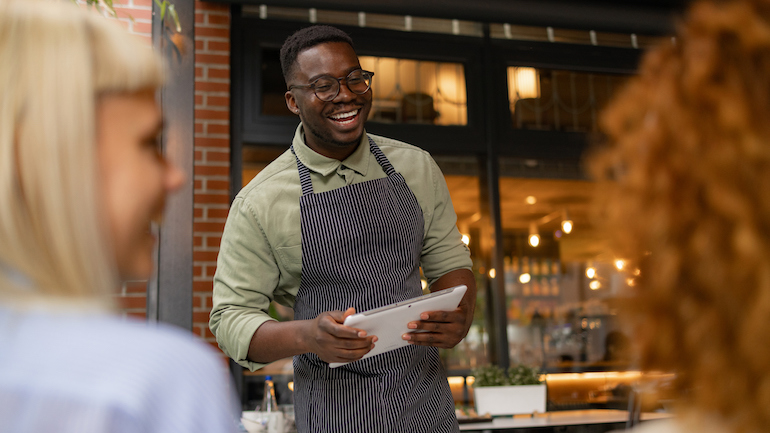As a restaurant operator, you’re no stranger to making decisions, whether it’s choosing who to hire as a new executive chef or which venue to choose for your next location. When making any of these decisions, in-depth research is essential. And when choosing the right restaurant management system and POS system, skipping the research stage is definitely not an option. This is especially important if you’re starting with basic questions like, ‘what is a POS system in a restaurant?’ and ‘what are the benefits of using a restaurant POS?’.
Indeed, taking the time to research and invest in the right technology will ensure you and your staff are set up for success in the long run.
Our article helps you through this research process by tackling the most frequently asked questions from restaurateurs, like yourself, when it comes to shopping for a restaurant POS system. We’ll walk you through the following to help you in the decision-making process:
- The definition of what is a POS system in a restaurant and what restaurant management software is
- An explanation of the difference between a legacy POS system and a cloud-based one
- What to look for when shopping for a POS system
- The cost breakdown of a POS system
- Top benefits of a restaurant management system
- Explanation of which members of your team should be involved in the decision-making process for purchasing a POS system
11 Frequently Asked Questions About POS Systems & Restaurant Management Software
Let’s dive into what you should be looking for when searching for a POS system and restaurant management software, so you can make an informed decision. Below, we’ve compiled a list of 11 commonly asked questions operators have while searching for technology to equip their venue with.
1. What Is Restaurant Management Software?
So what is restaurant management software? A restaurant management software expands on the basic transactional functionality of a POS system to include related restaurant operations software. With a restaurant management system, multiple products, such as marketing, loyalty, online ordering, and more, are integrated with the POS system to support other business operations.
2. What Is a POS System in a Restaurant?
First off, POS stands for point of sale system and refers to any place where a transaction takes place between a seller and buyer. However, in the restaurant industry, POS generally refers to the technology that makes up a POS system, not just the place of transaction.
So what is a POS system in a restaurant? A restaurant POS system is the software and hardware that allows restaurants to take orders, process payments, and track sales. A POS system ultimately helps you manage your business and acts as the engine of your operation.
3. What Are the Different Types of POS Systems?
There are also two types of POS systems commonly used by restaurant operators: a legacy POS system, otherwise known as a traditional POS system, and a cloud-based one.
A legacy POS system stores your restaurant’s data on-site on local servers through a closed internal network. When a legacy POS system is purchased, it needs to be installed and hardwired into one place. This setup means your data can only be accessed when you are physically present at your restaurant – not remotely.
On the other hand, a cloud POS system stores your data in the cloud via remote servers, allowing access to the data from anywhere, at any time, as long as you have an internet connection. Unlike a legacy POS system, the system is not hardwired in one place, which means staff can serve customers and process transactions from anywhere in the restaurant.
4. How Does a Restaurant POS System Work?
If you’ve been operating and handling your transactions manually, a POS system, like any new thing, is something you have to learn. So how does a restaurant POS system work? A restaurant POS system accepts payments and manages orders, as well as handling other moving parts of your operation.
For instance, when a customer places an order, the server can then input the customer’s order and send it to the kitchen. Once the customer is ready to pay, the server uses the POS system to process the payment. It’s important to remember that this process can differ depending on the type of POS system a restaurant is equipped with, whether that’s a legacy or cloud-based system.
5. What to Look for in a POS System?
When shopping for a restaurant POS system, it can be challenging to find the right one that suits your needs. To help ease your decision-making process, here is a quick list of what to look for in a POS system:
- Choose a POS system provider that offers reliable support throughout the onboarding process and additional support in the future, as issues may arise.
- Consider the ease of use of a POS system – how easy (or challenging) will it be to train new staff on the system?
- Assess the platform’s scalability or multi-location capabilities, especially if you own a franchise or plan to expand your business in the near future.
- Consider the upfront costs of a POS system, plus any additional costs associated with it, including additional hardware and software and maintenance.
- Look for any third-party software integrations you might need, such as reporting and analytics, inventory management, employee scheduling, reservations, online ordering, CRM, and loyalty.
The above considerations will depend on what size your restaurant is, the number of locations, and the concept type. It’s also important to be mindful that, depending on whether you choose a legacy or cloud-based POS system, your integration capabilities can be limited.
6. What Is the Best POS System for a Small Business?
If you operate a small business, such as a local restaurant, you may ask yourself what is the best POS system for a small business? The best POS system for a small business is one that’s affordable, intuitive, easy to use, and can grow with your business. For example, TouchBistro‘s all-in-one, cloud-based POS and restaurant management system is designed with operators and their staff in mind, making it perfect for small businesses.
7. How Much Is a POS System?
When considering how much does a POS system cost for a restaurant, it can vary depending on your restaurant type and what type of system (legacy or cloud-based) you’re looking for.
Legacy or traditional POS systems tend to have more expensive upfront costs. According to Grubhub for Restaurants, restaurateurs can pay upwards of $20,000 on hardware and installation for a legacy system. On the other hand, a cloud-based POS system can cost you around $1,000 for initial costs, plus monthly subscription fees of up to $300, ultimately making a cloud-based system significantly less expensive than a legacy system.
However, regardless of the type of POS system you go with, any additional costs depend on what you intend to add to your POS system to increase its capability and functionality, like additional software and integrations.

8. What Are the Benefits of Having a Restaurant Management System?
A restaurant management system (RMS) expands on the basic transactional functionality of your POS system by giving you access to additional solutions, which can significantly improve your restaurant operations.
We’d like to highlight a few of the top benefits of using a restaurant management system, including increasing sales, delivering a great guest experience, and saving time and money.
- Increasing Sales
A well-equipped restaurant management system has tools such as menu management software to help increase your sales. Menu management software can highlight your most profitable menu items to your staff, encouraging your servers to promote those items to your guests. As a result, this can lead to increased check sizes and sales for your restaurant.
- Delivering a Great Guest Experience
Virtually every RMS is equipped with tableside ordering, which helps your staff to take orders tableside and send those orders to the kitchen instantly. By doing so, your staff are able to reduce order errors, as well as manage payments more efficiently and ultimately, create a more positive experience for your customers.
- Saving Time and Money
As a restaurant operator, time and money are the most important components of operating a business. Fortunately, if your RMS is equipped with reporting and analytics software, this can help you identify ways to operate your restaurant much more efficiently and save both time and money.
9. Who on Your Team Should Weigh in When Deciding on a POS System?
The decision on which POS system to invest in for your restaurant can affect multiple team members. So who should weigh in on such a big decision?
There are multiple stakeholders who may want to weigh in on an important decision like a POS purchase. For example, restaurant group owners, director of operators, executive chefs, as well as finance, general, and restaurant managers.
Although your restaurant’s organizational structure may differ from the above, it’s important to be mindful that each stakeholder in your business will have different priorities and criteria when making a decision as significant as purchasing a POS system, so you need to take different perspectives into account. A general manager would be mindful of how easy the POS system is to use for their staff, while the finance manager is focused on the bottom line. Ultimately, though, the final decision-maker will likely depend on the size of your business and restaurant concept type.
To effectively gather each stakeholders opinions, you can host a brainstorming session, which allows you to get a sense of what in your operations is currently working and what needs to be fixed. This will allow your members to feel heard, as it gives them a voice in the process. And once a decision is made, you should provide training for your front and back of house staff, since they’ll ultimately be the ones using the POS system to interact with each other and guests.
10. Is it Easy to Use a POS System?
A POS system can be easy to use, especially if you find one that is user-friendly and intuitive, with extra training support available if needed.
However, ease of use can depend on the type of system and the software provider. When it comes to legacy or traditional systems that have been around in the restaurant industry for years, these systems may be familiar, but ultimately come with a steep learning curve. However, newer, cloud-based POS systems have been designed with modern restaurant operations in mind, so these systems are significantly easier to use and train new staff on.

11. Do POS Systems Need the Internet?
This answer depends on whether you’re looking into a legacy POS system or a cloud-based POS built with or without offline mode.
When talking about a legacy POS system, one of the biggest advantages is that it’s hardwired, which means it doesn’t depend on being connected to the internet to operate, so you’ll be able to keep operations running at all times.
On the other hand, one of the most common cloud misconceptions is that cloud-based POS systems cannot operate without the internet. In reality, cloud-based systems can be equipped with offline mode, so you can still operate the most essential parts of your restaurant without having to be connected to the internet.
For example, if your restaurant is equipped with TouchBistro’s cloud-based POS system, the system’s built-in offline mode means that your staff can still take orders to send them to your back of house, and process offline and cash payments, without an internet connection.
From knowing what is a POS system in a restaurant to the cost of one and everything in between, you’re well equipped to choose the right POS system for your restaurant. Best of luck in your search!
Get the Complete Guide to Restaurant Reservations
Sign up for our free weekly TouchBistro Newsletter







